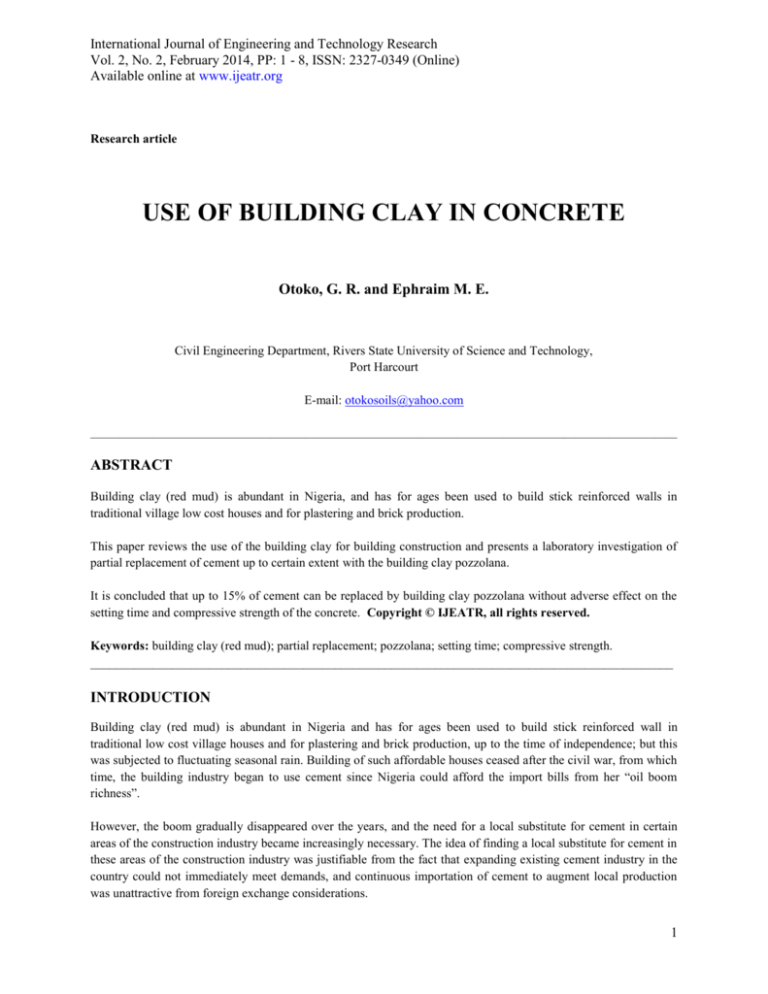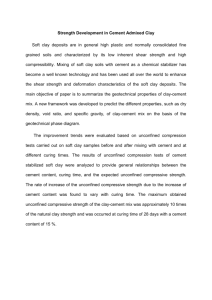
International Journal of Engineering and Technology Research
Vol. 2, No. 2, February 2014, PP: 1 - 8, ISSN: 2327-0349 (Online)
Available online at www.ijeatr.org
Research article
USE OF BUILDING CLAY IN CONCRETE
Otoko, G. R. and Ephraim M. E.
Civil Engineering Department, Rivers State University of Science and Technology,
Port Harcourt
E-mail: otokosoils@yahoo.com
________________________________________________________________________________________________________
ABSTRACT
Building clay (red mud) is abundant in Nigeria, and has for ages been used to build stick reinforced walls in
traditional village low cost houses and for plastering and brick production.
This paper reviews the use of the building clay for building construction and presents a laboratory investigation of
partial replacement of cement up to certain extent with the building clay pozzolana.
It is concluded that up to 15% of cement can be replaced by building clay pozzolana without adverse effect on the
setting time and compressive strength of the concrete. Copyright © IJEATR, all rights reserved.
Keywords: building clay (red mud); partial replacement; pozzolana; setting time; compressive strength.
_____________________________________________________________________________________________
INTRODUCTION
Building clay (red mud) is abundant in Nigeria and has for ages been used to build stick reinforced wall in
traditional low cost village houses and for plastering and brick production, up to the time of independence; but this
was subjected to fluctuating seasonal rain. Building of such affordable houses ceased after the civil war, from which
time, the building industry began to use cement since Nigeria could afford the import bills from her “oil boom
richness”.
However, the boom gradually disappeared over the years, and the need for a local substitute for cement in certain
areas of the construction industry became increasingly necessary. The idea of finding a local substitute for cement in
these areas of the construction industry was justifiable from the fact that expanding existing cement industry in the
country could not immediately meet demands, and continuous importation of cement to augment local production
was unattractive from foreign exchange considerations.
1
International Journal of Engineering and Technology Research
Vol. 2, No. 2, February 2014, PP: 1 - 8, ISSN: 2327-0349 (Online)
Available online at www.ijeatr.org
CLAY AVAILABILITY IN NIGERIA
A survey of clay deposits carried out by the geological survey of Nigeria identified the principal clay deposits
presented in table 1. Although some of the deposits are small, there are many that are vast and can serve as the
source of raw material for the building industry. Further information on clay availability in Nigeria, can be obtained
from Proda reports (1970, 1971, 1975,a, 1975b and 1975c)
Table 1: Principal clay deposits in Nigeria
S/No
1.
2.
3.
4.
5.
6.
7
8.
9.
10.
State
Benue and Plateau State
Imo, Ebonyi, Enugu and Anambra States
Kano State
Lagos State
Edo and Delta States
Borno State
Sokoto State
Rivers State
Akwa Ibom and Cross River State
Ogun State
Location of principal deposits
Jos, Ropp and Markurdi areas
Enugu, Ezi Akwu, Ekwe and Agbahara
Kano and Rimi areas
Epe, Ikorodu and Badagry areas
Benin city, Sapele and Ugheli areas
Maiduguri and Gombe areas
Sokoto and Kuban village
Port Harcourt and Andoni areas
Ekpene Obom area
Abeokuta and Ijebu-Ode areas
GEOTECHNICAL AND CHEMICAL PROPERTIES OF BUILDING CLAY
Building clay obtained from the Andoni area of Rivers State was used for this study. The geotechnical and chemical
properties of the building clay are hereunder shown in Tables 2 and 3.
Table 2: Geotechnical Properties of the Building Clay.
S/No
1
2
3
4
5
6
Geotechnical Properties
Clay Content
Silt Content
Sand Content
Specific Gravity
Optimum Moisture Content
Maximum Dry Unit Weight
13%
80%
7%
3.1%
25.5%
16.2 Km/m3
Table 3: Chemical Properties of the Building Clay
S/No
1
2
3
4
5
6
7
Chemical Properties
Fe2 O3
Al 2 O3
Ti O2
Si O2
Na 2 O
Ca O
Loss of Ignition
36%
18%
21%
7%
5%
3%
10%
2
International Journal of Engineering and Technology Research
Vol. 2, No. 2, February 2014, PP: 1 - 8, ISSN: 2327-0349 (Online)
Available online at www.ijeatr.org
REVIEW OF USE OF BUILDING CLAY IN MORTAR FOR MASONRY AND
PLASTERING
Building clay has for ages been used to build stick reinforced walls in traditional low cost village houses. It has also
been used as mortar and as a plastering material and it is suitable for bricks (chinwah and Otoko 1988).
a)
Suitability as Mortar
Considering the plasticity characteristics with cohesion suggested that the building clay would be suitable
for use as mortar for plastering as well as for bricks. Therefore, the following tests were conducted.
b)
Shear Tests
Shear strength tests were carried out by arranging three bricks made of the building clay, with the central
one protruding, and the set up tested
on a universal testing machine, with the force applied on the central
protruded brick till the mortar is sheared off.
c)
Tension Test
In order to measure induced tension, the bricks were jointed with
mortar, connected to the spring
balance and loaded, until failure due to
tension occurred. Soil alone showed very poor shear strength while soil
stabilized with cement ( up to 6% cement) gave good mortar. The study
showed that the mortar
could safely be used for partition walls
which are not directly exposed to rain water.
d)
Suitability as a Plastering Material
Building clay was used to plaster a set of three bricks, after which the smooth surface was left to dry
outside, and be subjected to heat and
wind. The resistance to rain water was tested by simulating a water
shower on it. The plaster made with soil alone cracked throughout,
while the plaster made with soil
cement remained smooth surfaced.
e)
Suitability For Bricks.
Chinwah and Otoko(1988) have shown that building clay is already
being used satisfactorily for brick
production. Fig 1 shows the location
of the brick plants in Nigeria, as at the time of visitation of the author to
the brick plants.
USE OF BUILDING CLAY POZZOLANA AS A PARTIAL REPLACEMENT OF
CEMENT IN CONCRETE
As defined in ASTM specification C618-78, pozzolanas are siliceous or siliceous and aluminous material which in
itself possesses little or no cementitious value but will in finely divided form and in the presence of moisture,
chemically react with calcium hydroxide at ordinary temperatures to form compounds possessing cementitious
properties. It has been suggested that, in addition to reacting with Ca(OH)2, pozzolanas react also with C3A or its
product of hydration (Collepardi et al 1978). A good review of the subject of pozzolanicity has been written by
Massaza and Costa (1979).
Pozzolanas are usually cheaper than the Portland cement that they replace but their chief advantage lies in slow
hydration and, therefore, low rate of heat development ( Bamforth, 1980); which is of great importance in tropical
construction works (Otoko and Chinwah 1991). Also, significant pozzolanic reaction reduces the porosity of the
paste (Kovacs, 1975); and reduces the permeability (Higginson, 1966); which is of importance in soil stabilisation.
3
International Journal of Engineering and Technology Research
Vol. 2, No. 2, February 2014, PP: 1 - 8, ISSN: 2327-0349 (Online)
Available online at www.ijeatr.org
Fly ash, known also as pulverised - fuel ash, is the most common artificial pozzolana; an extensive review has been
written by Berry and Malhotra (1980). The fly ash particles are spherical and are of at least the same fineness as
cement (Central Electricity Generating Board, 1972). Modern boiler plant produce fly ash with a carbon content of
about 3 percent but much higher values up to 12 percent is acceptable (price, 1975).
Although Nigeria has about 1296 million metric tonnes reserve of coal at Enugu and substantial deposits at Kaba in
Kwara State, Oji River Power Station is using it for the generation of electricity and therefore the only source of fly
ash in the country (Ngwu, 1984). Since the annual production rate of fly ash from only one station in Nigeria may
not meet local demands, there is therefore the need to explore the potential of the abundant building clay (red mud)
as pozzolana.
To prepare the pozzolana, building clay (red mud) was obtained from Ebukuma in Andoni area of Rivers State of
Nigeria, calcimined at 7000C, which falls within the range 5500C - 1000C given by price (1975). It was then ground
and sieved through the 45µm sieve which is a convenient basis of classification of size (Owens, 1979; Smith and
halliwel, 1979).
The effect of the different percentages of the pozzolona in cement and cement concrete were studied with respect to
the following;
Standard consistency, initial and final setting time of cement: tests on cement.
Compressive strength test on hardened concrete.
Figure 1: Brick Plants in Nigeria
4
International Journal of Engineering and Technology Research
Vol. 2, No. 2, February 2014, PP: 1 - 8, ISSN: 2327-0349 (Online)
Available online at www.ijeatr.org
EFFECT ON CONSISTENCY AND SETTING TIME
Table 4: Variations in Standard Consistency, Initial Setting and Final Setting Time with Building Clay Pozzolona
in Cement.
% Replacement
Standard Consistency
Initial Setting Time
Final Setting Time
0%
31
101
230
5%
31.5
96
225
10%
32.3
95
210
15%
33.0
100
231
20%
34.3
105
255
25%
35.5
110
280
300
Final Setting Time
Initial Setting Time
Consistency
250
200
150
100
50
0%
5%
10%
15%
20%
25%
Fig 2: Variation in Standard Consistency and in Setting Time.
EFFECT OF BUILDING CLAY POZZOLANA ON STANDARD CONSISTENCY OF
CEMENT
Fig 2 shows the variation of standard consistency with different percentages of building clay pozzolana in cement.
The standard consistency of ordinary Portland cement is 30.00, and increased with increase in pozzolana content.
The affinity for water also increased with increase in pozzolana content.
The affinity for water increased by 2.55%, 5.50%, 8.50%, 10.0% and 12.5% with pozzolana content of 5%, 10%,
15%, 20% and 25% respectively, compared with water required for standard consistency of ordinary Portland
cement, which shows a linear relationship with standard consistency. This proportional increase may have resulted
in the lighter weight of the pozzolana (specific gravity for pozzolana was found to be 2.30, compared with 3.15 for
cement).
5
International Journal of Engineering and Technology Research
Vol. 2, No. 2, February 2014, PP: 1 - 8, ISSN: 2327-0349 (Online)
Available online at www.ijeatr.org
EFFECT OF BUILDING CLAY POZZOLANA ON INITIAL SETTING TIME OF
CEMENT
Table 4 and fig 2 show the variation of initial setting time with different percentages of pozzolana replacement. BS
specification (BS EN 197-1:2011 specifies minimum setting time for OPC to be 30minutes; but for the cement used
for this study, the initial setting time was 101 minutes. It is observed from table 4 and fig 2 that initial setting time
gradually reduces for 5% and 10% pozzolana replacement whereas for 15% pozzolana replacement, it is nearly the
same as that of Portland cement, and thereafter increased for 20% and 25% pozzolana replacement.
EFFECT ON COMPRESSIVE STRENGTH
The effect of the pozzolana on the compressive strength of the concrete is shown in table 5 and in figures 3 and 4
below.
Table 3: Compressive Strength Of Different Amount Of Pozzolana Replacement
Sample
7days compressive strength in N/mm2
A
B
C
D
E
F
39.5
39.4
39.1
38.8
38.7
35.3
60.0
58.2
58.5
58.4
55.5
47.3
28days compressive strength in N/mm2
40
60
38
50
36
40
34
30
20
32
10
30
0%
5%
10%
15%
Building Clay Pozzolana Replacement
Figure 3: Variations in 7days
Compressive Strength
20%
25%
0
0%
5%
10%
15%
20%
25%
Building Clay Pozzolana Replacement
Figure 3: Variations in 28days
Compressive Strength
CONCLUSION
The decrease in the initial setting time at 5% and 10% pozzolana replacement may be due to the light weight of the
pozzolana. Table 4 shows that the rate of gain in strength decreases with increase in pozzolana content. From Table
2, the optimum pozzolana replacement is 15%, at which the setting time is almost the same as for 0% pozzolana
replacement of cement, and at which compressive strength is not more than about 2.68% less than the compressive
strength at 0% pozzolana replacement.
6
International Journal of Engineering and Technology Research
Vol. 2, No. 2, February 2014, PP: 1 - 8, ISSN: 2327-0349 (Online)
Available online at www.ijeatr.org
This means that up to 15% of cement can be replaced by building clay pozzolana without adverse effect on the
setting time and compressive strength of the concrete.
Since ash is produced from only one power state in Nigeria and at a production rate that may not meet demands, it is
concluded that the Nigerian Government should embark on commercial production of building clay pozzolana,
especially as the clay is abundant in Nigeria, and thereafter specify the use of the pozzolana in all appropriate
construction involving Government funds.
ACKNOWLEDGEMENT
The authors are grateful to Mr. Ikiriko Lolo David for assistance with some aspects of field and laboratory work.
REFERENCES
[1] ASTM specification 618-78. Specification for fly ash and raw of calcined natural pozzolana for use as a mineral
admixture in Portland Cement Concrete.
[2] British Standard Institution (BS EN 197-1:2011. Cement composition, specification and conformity criteria for
common cements.
[3] BAMFORTH, P. B. 1980. In situ measurement of the effect of partial Portland cement replacement using either
fly ash or granulated blast-furnace slag on the performance of mass concrete, Proc. Inst. C. E., London, part 2, 69,
pp. 777-800.
[4] BERRY, E. E. AND MALHOTRA, V. M. 1980. Fly ash for use in concrete. A critical review, J. Amer. Concr.
Inst., 77, No. 8, pp. 59 - 73.
[5] CENTRAL ELECTRICITY GENERATING BOARD. 1972. Pfa utilization, 104 pp. (Wolverhampton).
[6] CHINWAH, J. G and OTOKO, G. R. 1988. A review of brick technology in Nigeria. The journal of the Nigerian
Institute of Structural Engineers, vol. 1, No. 2, pp. 22-29.
[7] COLLERPARDI, M.; BALDINI, G.; and PAURI, M. 1978. The effect of pozzolanas on the tricalcium aluminate
hydration. Cement and Concrete Research, 8 no. 6, pp. 741-51.
[8] HIGGINSON F. C. 1966. Mineral admixtures, ASTM Sp. Tech publication, No. 169-A, pp. 543-55.
[9] KOVACS, R. 1975. Effect of hydration products on the properties of fly ash cements. Cement and concrete
Research, 5, No.1, pp.73-82.
[10] MASSAZZA, F. and COSTA, U. 1979. Aspects of the pozzolanic activity and properties of pozzolanic
cements. II cemento, 76,No.1, pp. 3-18.
[11] NGWU,F. N. 1984. Nigeria Coal Corporation; Production of Ore Coals. Weekly Star, Nigeria.
[12] OTOKO, G. R. and CHINWAH, J. G. 1991. The use of 'Garri' as admixture in hot weather concreting. The
journal of the Nigerian Institute of Structural Engineers, vol. 1, No.4, pp. 13- 18.
[13] OWENS, P. L. 1979. Fly ash and its usage in concrete. Concrete, 13, No. 7, pp. 21-6.
[14] PRICE, W. H. 1975. Pozzolans - a review. J. Amer. Concr. Inst., 72, No. 5, pp. 225-32.
7
International Journal of Engineering and Technology Research
Vol. 2, No. 2, February 2014, PP: 1 - 8, ISSN: 2327-0349 (Online)
Available online at www.ijeatr.org
[15] PRODA 1970. Survey of clay deposits in the Bendel State of Nigeria: Report to the ministry of Trade, Industry
and Co-operations (Industries Division). Benin City.
[16] PRODA 1971. Clay deposits in Benue- Plateau State of Nigeria- Deposition and suitability to structural bricks
and pottery wares- Reports to the Government of the Benue Plateau State of Nigeria.
[17] PRODA 1975a. Clay deposits in the East Central State, Nigeria - A Pre- Feasibility Study- Report to the
Nigerian Mining Corperation.
[18] PRODA 1975b. Estimation of clay reserves at waram - Kaduna Prospectors (Nig.) Limited - Report to the
Government of Benue- Plateau State of Nigeria.
[19] PRODA 1975c. Estimation of clay reserves at Awkunanaw, Enugu: Report to the Nigerian Mining Corperation.
[20] SMITH, M. A. and HALLIWELL, F. 1979. The application of the BS 4550 test for pozzolanic cements to
cements containing pulverized - fuel ashes. Mag. Concr. Res., 31, No. 108, pp. 159-70.
8




![[1.1] Prehistoric Origins Work Sheet](http://s3.studylib.net/store/data/006616577_1-747248a348beda0bf6c418ebdaed3459-300x300.png)



